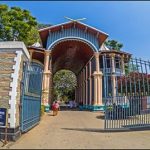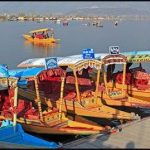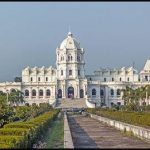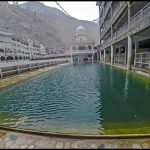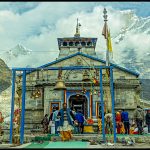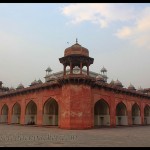Once every twelve years, a temporary city, sprawling across miles along the confluence of the Ganga and Yamuna rivers, emerges from the riverbed. This vibrant city, a testament to faith, is home to countless grand tents and makeshift structures, accommodating millions of pilgrims from across India. Devotees, carrying their belongings, embark on a journey of faith to immerse themselves in the holy Sangam – the confluence of the Ganga, Yamuna, and the mythical Saraswati rivers. Thousands of visitors reside there to undertake the month-long intense spiritual practice known as ‘The Kalpvas’.
This congregation, a spectacle unparalleled in scale, witnesses a gathering of millions of Hindus in the holy land. Nowhere else can such a massive congregation of devotees, saints, and sages be witnessed.From the land of Prayagraj, the spirit of Sanatan Hinduism resonates powerfully during the annual Magh Mela, the Ardh Kumbh every six years, and the grand Purna Kumbh every twelve years.
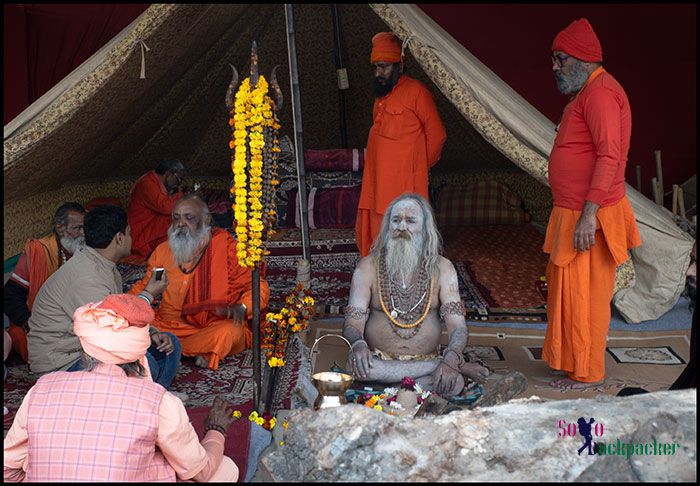
In 2025, the Purna Kumbh will take place from January 13th to February 26th. 2025 Kumbh is special in the sense that not only is it the year of the Purna Kumbh Mela, but also a Maha Kumbh, a rare celestial alignment that occurs only once every 144 years, following a cycle of twelve Purna Kumbhs. This post offers essential information about the Maha Kumbh to help you navigate the city amidst millions of visitors. The crowd situations and traffic restrictions discussed here are applicable during the Mahakumbh only. You may use this post as a general guideline to visit Prayagraj city in future, however this zone wise description may not be applicable after the Mahakumbh.
How to navigate during Mahakumbh, 2025?
The entire Mahakumbh area is officially divided into 25 sectors, numbered from Sector 1 to Sector 25, across the riverbeds of the Ganga and Yamuna and surrounding areas. This area is declared as a separate district from Prayagraj and named as Mahakumbh Nagar. However, for simplicity, I will not delve into the sector-wise details and will instead divide the city into the following five zones:
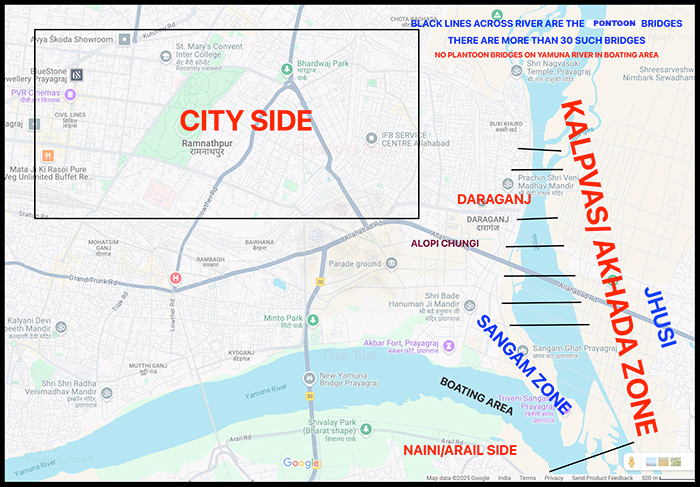
1. Main Prayagraj City: The regular Prayagraj city area featuring three railway stations: Prayagraj Junction (station code: PRYJ), Subedarganj (station code: SFG), and Prayagraj Rambag (station code: PRRB). Prayagraj Airport (code: IXD) is located approximately 14 km from the city center. This zone offers major markets, a wide range of hotels, diverse shopping and dining options, and notable tourist attractions like Azad Park, Anand Bhawan, and Khusro Bagh.
From Prayagraj, visit Varanasi also: Popular places to visit in Varanasi
Transportation/Accommodation Options:
1. Wherever you stay in the main city, expect to get hassle-free public transports to commute unless you are moving to Sangam area. Plenty of auto-rickshaw, e-rickshaw and low floor buses are available. You can book e-rickshaw delicately or simply hop-on, hop-off with other passengers.
2.Few restrictions are imposed at the railway stations to avoid crisscrossing and overcrowding., e.g. at Prayagraj Junction, entry is from Leader Road side and exit is from Civil Lines side. Similarly, at Subedarganj Railway Station, entry is from Jhalwa side and exit is from GT Road (Sulemsarai) side.
3.Keep in mind that Prayagraj Express, the most popular train, between New Delhi -Prayagraj is not operating from Prayagraj junction, but from Subedarganj Railway Station.
4.Except a bit of traffic jam here and there, the city is smooth to navigate like regular days unless someone moving towards Sangam/Daraganj Area.
2. Sangam Zone: The Sangam (Sector 3 and 4 officially ) is the heart and soul of the Maha Kumbh. All pilgrims aspire to bathe in its sacred waters. It features several bathing ghats and prominent temples, including Shri Bade Hanuman Ji Temple, Akshayvat Corridor, Samudrakup, Patalpuri Temple, and Shankar Viman Mandapam. Prayagraj Fort (Akbar Fort) is also there, but being an army area, it is out of bound for the visitors.
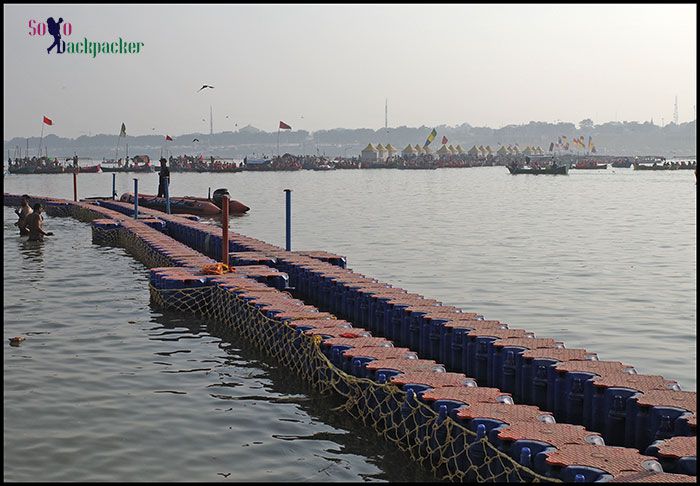
Transportation/Accommodation Options:
During the Maha Kumbh, public transport generally does not operate in this area. However, a few e-rickshaws may cross the pontoon bridges over the Ganga River from the Jhusi side. Once the Maha Kumbh concludes, it becomes a regular city area where people can move around freely.
The most convenient approach to reaching the Sangam Zone is to first arrive at Alopi Chungi from your location within the city. From there, you’ll need to walk at least 2 km to get to the Sangam. Alopi Mata Temple (Shaktipeeth) is at the walking distance from Alopi Chungi. Please note that transportation options beyond Alopi Chungi, including e-rickshaws, may be limited or unavailable.
The area around Sangam is officially known as the Parade Ground (Sector 1 and 2). It primarily accommodates administrative functions, including temporary offices, government agencies, and a tent city provided by UPSTDC. Regular visitors don’t stay here and accommodations are largely restricted to government officials overseeing Kumbh operations and those who have pre-booked in the tent city.
This zone is primarily recommended for visiting the Bade Hanuman ji Temple, the Akshayvat, and for bathing purposes. Expect significant crowds at the Akshayvat Corridor and the Shri Bade Hanuman ji Temple. Please note that temple darshan will be suspended on the day of the Shahi Snan. However, as a regular visitor, you can still enter the zone on Shahi Snan day. Designated areas along the route allow you to witness the grand Shahi Snan processions led by the Akhadas.
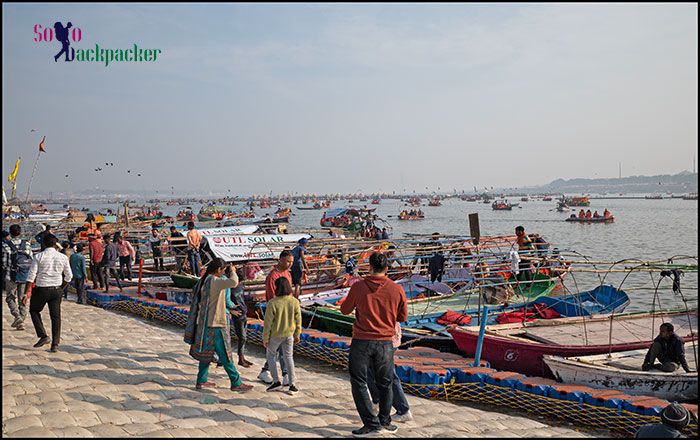
Bathing Options:
You have multiple options for bathing: the Ganga River, the Yamuna River, and the Sangam, where both rivers converge. Unlike the famed ghats of Varanasi, most Sangam ghats are constructed using sandbags. However, these ghats provide clean and comfortable bathing areas for a distance of 2 kilometers along the Sangam. The Yamuna has concrete ghats near the fort as well as in Arail side, while the Ganga has one near Daraganj. Further upstream on the Ganga, other bathing ghats along a 5-6 km stretch from the Sangam to Phaphamau are also developed using sandbags. Boats can also be hired from the ghat near the Fort or from Boat Club, allowing you to bathe in the middle of the Sangam, where platforms and changing rooms are provided for convenience.
3. Daraganj Zone: Daraganj is an important area of the city close to the Sangam, primarily known for the Nag Vasuki Temple. You can find an auto or e-rickshaw to Daraganj from Alopi Chungi, the Railway Stations, and Civil Lines. It is approximately 2 km away from the Sangam.
The nearby railway stations include Prayag (Station Code: PRG), Prayagraj Rambag (Station Code: PRRB), and Prayagraj Sangam (Station Code: PYGS). Please note that Prayagraj Sangam station remains closed for three days during the Shahi Snan, including the day before and the day after.
4. Akhada/Kalpvas Zone: This zone spanning across 7-8 km in the riverbed of Ganga river from Sangam to Phaphamau serves as the primary residential area for sadhus, sages and devotees (kalpvasis). It has all the grand pandals of Akharas, cultural pandals and the tents of kalpvasis. To facilitate movement between the city and this zone, approximately 25 pontoon bridges have been constructed. Given the large area of this zone, a thorough understanding of the official sector designation is essential for efficient navigation. The entire zone is meticulously divided into sectors 6-10 (Daraganj to Govindpur direction), followed by sectors 11-22 ( Phaphamau/Govindpur to Sangam direction). Sector 5 is also in this zone near the Sangam.
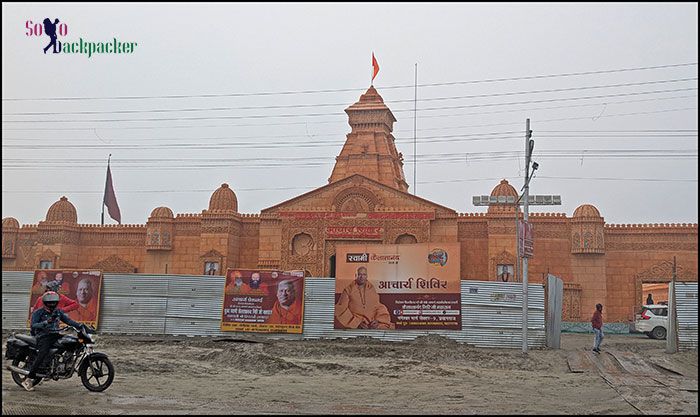
In addition to the pontoon bridges from the Sangam and Daraganj areas, this zone is also accessible from the Jhusi side, from the Gangeshvar Temple in Govindpur side, and the IERT side. The nearby railway stations include Prayag (Station Code: PRG), Phaphamau (Station Code: PFM), and Jhusi (Station Code: JI).
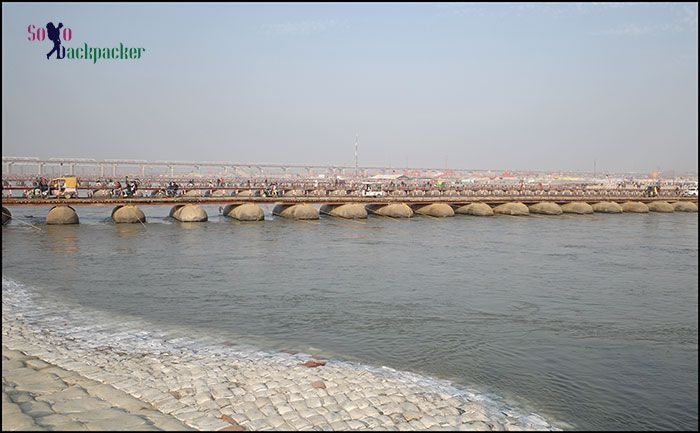
You can find autorickshaws or e-rickshaws to commute within this zone. If you take a rickshaw from the Jhusi or Govindpur side, the ride is usually traffic-free. However, if you travel from the Daraganj or Sangam side, you may encounter more congestion.
The main Shashtri Bridge across the Ganga River (on the Prayagraj-Varanasi Highway) and the Yamuna Bridge (connecting the city with the Naini side) are primarily used by public transport for inter-district travel. Once you enter the city, you are unlikely to need to use these two bridges, as you will mostly rely on the pontoon bridges for commuting.
5. Tent City/Arail/Naini Zone: This zone is located on the opposite side of the Yamuna River, across from the Sangam/Prayagraj Fort. Officially, it includes sectors 23, 24, and 25 of Mahakumbh Nagar.
This zone features several upscale tents in the tent city, developed by UPSTDC and private players, with prices starting at ₹ 10,000 per night. It also offers a well-developed viewpoint of the Sangam, a concrete bathing ghat, and the recently developed Sivalaya Park.
Transportation/Accommodation Options:
Main railway station in this zone is Prayagraj Cheoki Railway Junction (Station Code: PCOI). To commute from this zone to the Sangam area, you have following options:
1. To use a boat across the Yamuna river.
2. To cross the Yamuna river by New Yamuna Cable Bridge and then walk from approx 2 km from the main road to the Sangam.
3. To use one of five pontoon bridges between Naini and Jhusi side riverbed. From there, you can use other pontoon bridges to reach the Sangam. This is a good option to reach Akhada/Kalpvas zone from Naini side.
Common activities to do:
1. Bath in Ganga River/Yamuna River/ Sangam
2. Stay in Tents for a week/month (Kalpvas)
3. Walk around in the Akhada Zone/Offer prayers/Observe the life of Sadhus
4. Listen Pravachan/Bhajan etc in Akhada Zone. Learn and experience the essence of Sanatana Dharma/Hinduism
5. Visit Akshayvat, Shri Bade Human ji Temple, Alopi Mata Temple, Nag Vasuki Temple, Anand Bhawan, Khusro Bag, Azad Park.
6. Enjoy cultural programs at cultural pandals like Kalagram, Ganga Pandal, Kalakumbh, UP Darshan Mandam.
Enjoy Ganga Aarti in Varanasi: Ganga Aarti in Varanasi
Accommodation Options in Prayagraj during Mahakumbh:
1. Hotels/Homestays in the main city
2.Tents in the Tent City by UPSTDC or by the private players
3. If you have any contact information for the sadhus from the Akhada, you can book tents for an extended stay in the Akhada area. They offer paid tents for devotees.
4. If you prefer to stay for free, bring your own winter clothes and blankets. You can sleep in the large covered tents alongside hundreds of other devotees. Such tents are already set up by the government as well as the many akhadas/organizations.
Food Options during Mahakumbh: Plenty of options are available in Mahakumbh area for delicious vegetarian foods. Many organisations are also running Bhandaras, providing free meals to the pilgrims.
Things to do other than the Snan at Sangam:
Along with the religious rituals, this year’s Mahakumbh also highlights a cultural extravaganza showcasing the rich heritage of India, particularly from Uttar Pradesh. The Kumbh area features several must-visit attractions where you can experience India’s rich cultural diversity and historical grandeur. For example:
1. Kalagram, set up by Ministry of Culture, Govt of India in Sector-7 of Kumbh Area:
This cultural village is set up in a huge area (approx 10 acre) to to highlight India’s spiritual and cultural richness. It is approx 6 km from Sangam, 3 km from Nagvasuki Temple, Daraganj and 2 km from Prayag Junction. The place is well marked at Google Maps as Kalagram (कलाग्राम संस्कृति मंत्रालय भारत सरकार).
This cultural village will highlight art, heritage, food, and performances, bringing together thousands of artists from across the country. The venue will feature five stages, including the main Kalagram stage, where over a thousand artists will perform during the Mahakumbh.
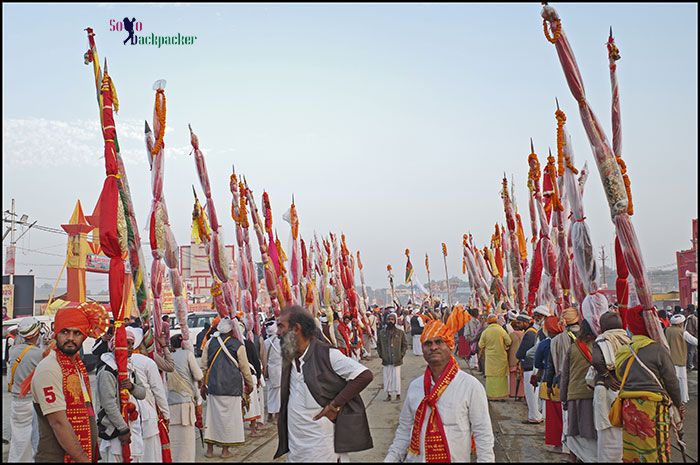
As of now, entry is free in Kalagram. They may charge a nominal fee later on.
2. Kala Kumbh set up by Sanskriti Vibhag, Govt of UP in Sec-7:
Adjacent to the Kalagram, this pandal will showcase the cultural diversity of Uttar Pradesh. It includes a gallery showcasing photographs, replicas, monuments from Uttar Pradesh, protected heritage sites, manuscripts, and artifacts, along with a stage for cultural performances. A detailed section is dedicated to the history of Kumbh. Entry Free.
3. Uttar Pradesh Darshan Mandapam set up by Tourism Dept, Govt of UP in Sec-7:
This pandal explains the various tourist circuits like Ramayana Circuit, Krishna Brij Circuit, Bundelkhand Circuit, Buddhist Circuit etc from the state of UP. The main pavilion exhibits a grand depictions on the religious sites from Uttar Pradesh. Visitors can also enjoy the taste of Uttar Pradesh at many food stalls. Entry Free.
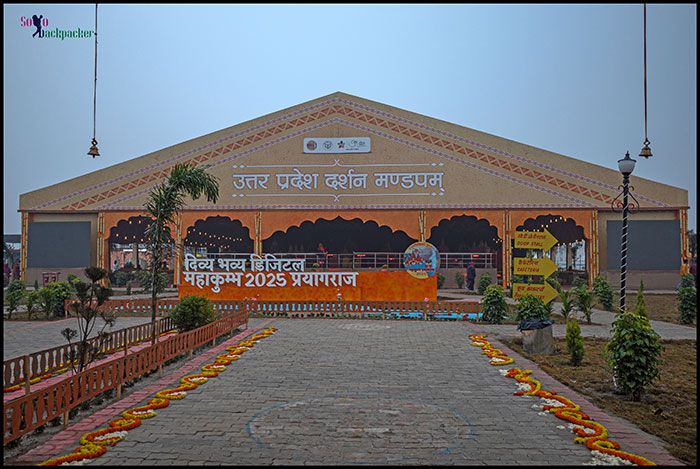
4. Digital Mahakumbh Experience Center near Shri Bade Hanuman ji Temple, Sangam Area:
This center digitally portrays the mythological stories behind the Mahakumbh Mela AI, VR/AR, LiDAR technology, LED displays and holograms. It’s all together a different experience. As of now, entry fee is ₹ 50. Expect big crowd as the Mahakumbh progress.
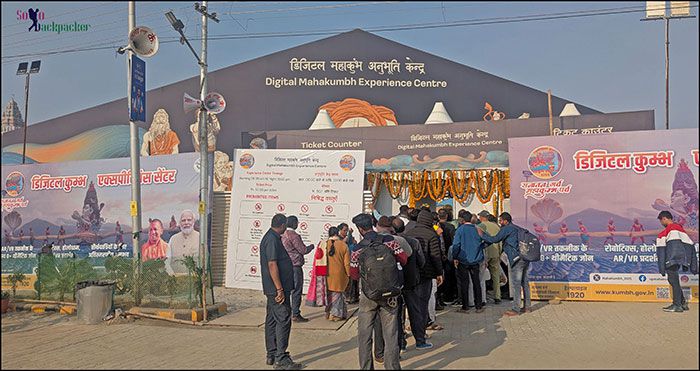
5. Ganga Pandal, Parade Ground Sector 1 (Main Sangam Zone, Near main entrance of the fort)
Ganga Pandal will have the capacity of at least 10000 people and have the performance from the renowned artists like Shankar Mahadevan, Mohit Chauhan, Kailash Kher, Hans Raj Hans, Hariharan, Kavita Krishnamurthy etc.
Entry Free. Timing 0400 PM Onwards.
6. Shivalaya Park, Arail (Naini Side, opposite bank of Yamuna River):
It’s a religious park set up in a large area. The park has the replica of 12 Jyotirlingas and many Shiva temples from the country. Entry Fee is ₹ 50.
Other notable pandals include the Acharya Shivir of Swami Kaliashananda, the ‘Mahamnadleshwar’ of Niranjani Akhara and the pandal of Shri Ashutosh Maharaj. While other Akharas are concentrated near Sangam, few notable sadhus/mahatmas are having their grand pandals far away from the main Sangam Area. Approx 6-7 km in this case near Gangeshwar Mahadev Temple, Govindpur, Salori.
An idea about Holy Bath at Sangam during Mahakumbh, 2025:
Please note that this is just the basic information. Administration is trying to facilitate the smooth movements of people and vehicles, so that you can walk bare minimum. But here, we are talking about millions of people gathering in a relatively smaller area. When crowd swells, all arrangements and guidelines can change without any advance notice.
Shahi Snan (Amrit Snan) Dates:
For Mahakumbh 2025, the Amrit Snan will be on the day of Paush Purnima, which is January 13. Then on Makar Sankranti, January 14, then on Mauni Amavasya, which is on January 29, after that on Basant Panchami, which is on February 3, followed by Maghi Purnima, on February 12, and will end on Maha Shivratri on February 26.
1. Bath during Amrit Snan Days:
Millions of people reach arrived in Prayagraj on these auspicious days. All the sadhus/mahatmas from the Akhada take holy dip in the Sangam. It’s called a Shahi Snan (now Amrit Snan) because on this day, the procession of all akhadas to the bathing ghats looks like a royal parade. It’s a grand and lively event, with chants filling the air and beautiful palanquins, decorated horses/elephants/camels, flower-covered chariots, and marching bands.
What you can expect on these days as General Public?
The shahi snan by Akhadas starts in the morning 0500 AM till the evening 0600 PM. The procession will enter the Sangam area from Akhada area via a pontoon bridge near Sangam and then leave the area via a road adjacent to Akshayvat/Bade Hanuman ji Temple, another pontoon bridge to their respective camps on the other side of the river. One more pontoon bridge is reserved for government officials. Another one is reserved as a stand by.
All the Amrit Snan is being held on the designated ghats, but practically, the Sangam area is barricaded for smooth sailing of processions. There are designated areas on the procession route from where general public can watch the event. The procession route is almost the entire bathing area in the Sangam Zone, so I don’t think anybody would be able to take holy dip at Sangam during the Shahi Snan. You can only take dip in the evening and night once the area is cleared by sadhus/mahatmas.
For general public, bathing options during the day are in the Ganga River from Sangam area towards Phaphamau beyond the procession route. You can also take bath on the opposite bank of Sangam in the Ganga and Yamuna river. You may able to take dip in the Yamuna River towards Arail/Naini side and near the fort also during the day. In nutshell, main Sangam area is out of bound for the general public except just near the fort side for the bathing purpose on the Amrit Snan days.
2. Bath during normal days (other than Amrit Snan):
You can go upto main Sangam area. You can take bath wherever you wish. Very few traffic restrictions are there, but still expect to walk for 2-3 km.
Traffic Restrictions:
1. Normal days: It is possible to reach upto Kalpvas/Akhada area. Very convenient from Jhusi and Naini/Arail side using pontoon bridges. A bit difficult if you proceed via main city (Alopi Chungi side). Expect to walk for 2-3 km on normal days, especially from the city side.
2. Amrit Snan Days: Vehicles coming from Prayagraj have to stopped at designated parking places around the city. From there, you can use shuttle buses/onwards public transport towards Sangam. Expect to walk for at least 4-5 km. This restriction starts one day prior to the date of the Shahi Snan and end one day after the Shahi Snan (Total 03 Days). For Mauni Amavasya (Jan 29), this restriction starts two days prior and end one day later (Total 04 days).
Update on Mahakumbh, 2025 after first Amrit Snan/Shahi Snan (Makar Sankranti):
1. All estimates of the arrival of devotees were shattered. On the occasion of Makar Sankranti, the administration had estimated that about two crore people would come, but by evening more than three and a half crore people had arrived and still counting till late night.
2. The arrangements collapsed due to more than the anticipated crowd. At one place, the crowd also broke the barricades and entered in restricted area, due to which the royal bath was delayed by an hour. Still, the situation remained under control.
3. The entry of vehicles into the city was controlled to a large extent (almost a ban on outside vehicles). Despite the shuttle buses from the designated parking, devotees have to walk at least 10 km. Auto drivers are charging arbitrary fares. It is common to walk 8-10 km on the occasion of Shahi Snan.
4. As per the railway’s pre-determined plan to run additional trains on demand, the railway had to run 46 on-demand trains.
5. Thousands of people had to spend the night roadside due to lack of space in the shelters built at the railway station.
6. There is severe cold and fog in Prayagraj. Due to fog, most of the trains reaching Prayagraj are running 5-10 hours late. More than 4000 people have fallen sick due to severe cold, 6 devotees have died, more than 200 people have been separated from the families. This number may seem less in the crowd of crores, but every life is important.
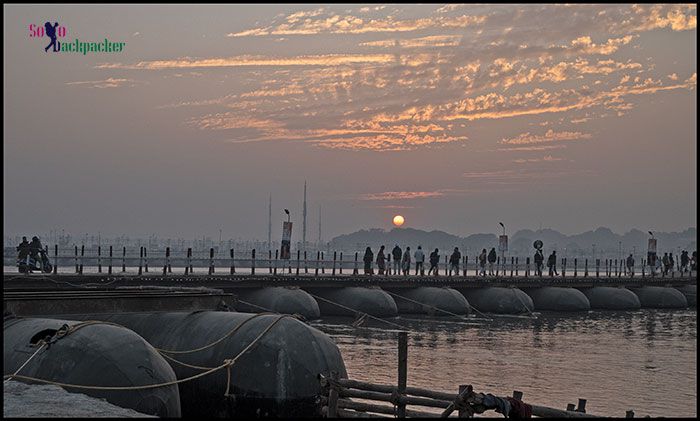
7. The maximum crowd in Prayagraj gathers on the Amrit Snan of Mauni Amavasya (29 January). Learning lessons on Makar Sankranti, the administration has decided to implement the zonal plan on the occasion of Mauni Amavasya. Under this, entry of outside vehicles will be restricted in the city from two days before till one day after Mauni Amavasya. Those coming from Varanasi will be allowed to take bath at Jhunsi, those coming from Lucknow will be allowed to take bath at Dashashwamedh Ghat, Govindpur and then Phaphamau when the crowd increases. Those coming from Mirzapur, Rewa will be allowed to take bath at Arail and those coming from Kanpur will be allowed to take bath at Sangam. Bathing in the Ganga river will be restricted on the left side of Sangam. Barricading will be strengthened and this plan will be strictly implemented.
Note: Mahakumbh Nagar is now well marked on the Google Maps.
From Prayagraj, visit Chitrakoot also: Popular places to visit in Chitrakoot
Except the Shahi Snan, everything is fine on the other days. It’s still very well managed and as per the expectations. The efforts of the administration and volunteers are worth appreciating. But, if you are coming to Prayagraj on the occasion of Mauni Amavasya, then come with full preparation. Come with the intention of walking 10 km. If there is a lot of crowd and cold, then take special care of the elderly and children. May Maa Ganga fulfill all your wishes in the journey from end to eternity.


